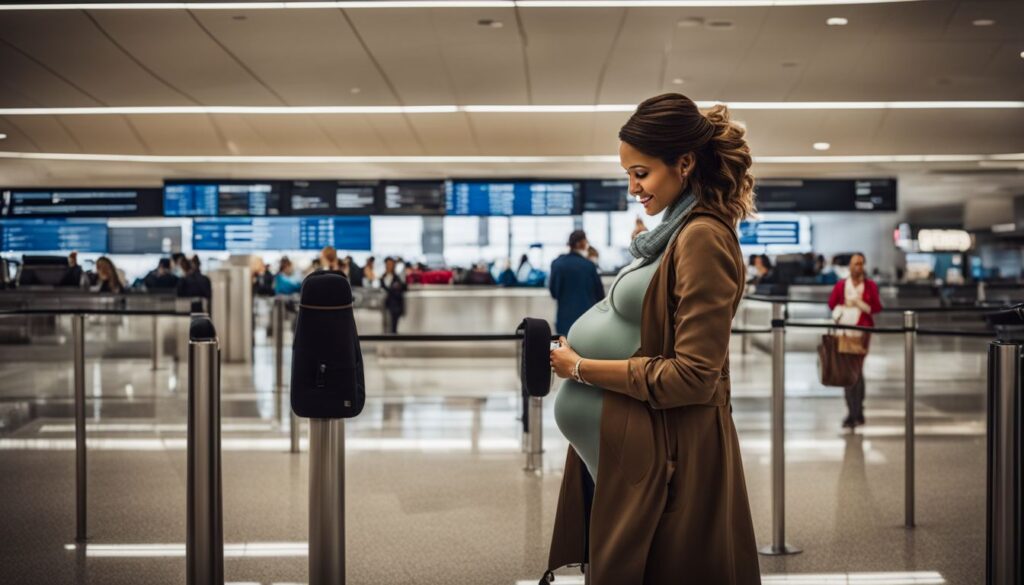How Late In Pregnancy Can You Fly Safely?

You can fly until you are 36 weeks pregnant if your pregnancy is going well. This article shares tips on flying safely at different times during your pregnancy. Keep reading for helpful advice!
Most women can fly safely up to 36 weeks of pregnancy. However, always check with your doctor first, especially as you get closer to your due date.
Early in pregnancy, flying is generally safe. But, it’s wise to walk around every so often during the flight.
As you get further along, choose an aisle seat for easier bathroom access and more chance to stretch your legs.
Wear loose clothing and comfy shoes. Stay hydrated by drinking plenty of water before and during the flight.
Lastly, always have a copy of your medical records handy when traveling.
Understanding Air Travel During Pregnancy
Is it safe to fly while pregnant? Considerations change throughout pregnancy. Flying in each trimester poses different challenges and precautions.
Is it safe to fly while pregnant?
Flying while pregnant is mostly safe. Experts say flying does not cause miscarriage, early labor, or waters to break. Women with normal pregnancies can fly safely and should take usual travel steps.
If pregnant, try to fly before you reach 37 weeks, or 32 weeks for twins. This lowers any risks. The best time to fly is between 18 and 24 weeks when morning sickness often gets better.
Always check with a healthcare provider about flying if there are concerns of complications.
What should you consider?
You can fly until you are 36 weeks pregnant if you have a normal pregnancy. If you are expecting twins or more, the safe limit is up to 32 weeks. The second trimester is the best time to travel by plane when pregnant, as you’re likely to feel your best.
Always check with your doctor before flying close to your due date.
Flying in each trimester
After considering the various factors that impact air travel during pregnancy, it’s critical to understand how flying differs across trimesters. Each stage of pregnancy presents unique challenges and considerations, influencing the safety and comfort of air travel.
| Trimester | Considerations | Recommendations |
|---|---|---|
| First Trimester (0-12 weeks) | Risk of nausea and fatigue. Higher miscarriage risk. | Short flights preferred. Stay hydrated. Move regularly. |
| Second Trimester (13-26 weeks) | Lower miscarriage risk. Optimal energy levels. | Best time for air travel. Use seat belts under the bump. |
| Third Trimester (27-40 weeks) | Increased discomfort. Higher risk of blood clots. | Consult healthcare provider. Avoid long flights. Wear compression socks. |
The second trimester stands out as the ideal time for air travel, balancing comfort with lower health risks. Yet, all travel plans must align with healthcare advice and airline policies for a safe journey.
Preparation Before Flying

Before you fly during pregnancy, consult with your healthcare provider and check airline policies. Also, consider travel insurance to ensure a safe and stress-free journey.
Consult with your healthcare provider
Check with your doctor or nurse if you can fly while pregnant. They will know if it’s safe for you and the baby. This talk is good to find any health problems or pregnancy issues that could make flying a bad idea.
Your GP or practice nurse will tell you how fit you are to fly when expecting.
They give advice just right for each part of your pregnancy. This helps keep you and the baby well when flying. It makes sure risks are low and comfort is high, no matter how far along in pregnancy you are.
Check airline policies
When planning to fly during pregnancy, check the airline’s rules first. Airlines set their own rules for pregnant passengers.
- Flying until when – Most airlines allow flying up to 36 weeks for a single baby. For twins or more, this time might be shorter. Know how far along in pregnancy you can fly with them.
- Doctor’s note needed – After a certain week, some airlines need a doctor’s note. This note should say you’re okay to travel and include your due date.
- Rules for complications – If your pregnancy has complications, the airline might have stricter rules. You may need special medical permission to fly.
- Long flight limits – The longer the flight, the stricter the rules might be. Check if there are limits on how far pregnant you can be for long trips.
- Changes because of pregnancy – Find out about refunds or changing flights if pregnant problems come up.
This info will make flying while pregnant easier and safer.
Consider travel insurance
Before you plan to fly while pregnant, check the airline’s rules. Also, think about getting travel insurance that covers both you and your unborn baby. Some policies will also cover if your baby comes early during your trip.
It’s important to know what is and isn’t included for pregnancy in your insurance.
Talk to your insurer to find out if becoming pregnant after buying the policy changes anything. This step helps make sure there are no surprises later. It keeps both mother and baby safe during flights, no matter how far along in pregnancy you are or up to when you can fly while pregnant.
Tips for Safe Flying During Pregnancy
Stay hydrated, move around and stretch, wear compression socks, consider booking an aisle seat. This will make your flight more comfortable. Read the full article for more important advice on flying safely during pregnancy.
Stay hydrated
Drinking water is very important during flights. The air on planes is dry and can make you dehydrated quicker. This is especially true for pregnant travellers. They need to drink more water while flying.
Air travel means you should drink lots of water, whether you’re pregnant or not.
Moving around every 30 minutes also helps. It keeps your blood moving and fights off dehydration in the air. Pregnant women flying far along into their pregnancies must take extra care with this.
Move around and stretch
It’s vital to keep your blood flowing during a flight, especially when you’re pregnant. Try stretching and moving around every hour or so. Rotating your ankles and doing some simple leg exercises while seated can also help prevent any discomfort or potential issues related to sitting still for too long.
Remember the important fact: regularly stretching and moving your legs during a flight helps ensure safe travel during pregnancy.
Wear compression socks
Compression socks are crucial for pregnant women during air travel to support their circulation. These special stockings help reduce the risk of blood clots by applying gentle pressure, promoting healthy blood flow in the legs.
By wearing compression socks, pregnant women can alleviate the strain on their circulation caused by long flights and decrease the chances of developing deep vein thrombosis. It’s essential for expectant mothers to wear graduated elastic compression stockings recommended by healthcare professionals specifically designed for air travel.
Moving forward to “Consider booking an aisle seat”…
Consider booking an aisle seat
When flying during pregnancy, it’s a good idea to choose an aisle seat. This way, you’ll have easier access to walk around and stretch your legs as needed. It can also be helpful for getting to the restroom without disturbing other passengers too much.
And don’t forget, staying mobile during the flight is important for keeping blood circulation flowing well throughout your body!
Avoid flying if you have certain pregnancy complications
If you have certain pregnancy complications, it’s best to avoid flying. Always consult your healthcare provider if you’re unsure. It’s essential to prioritise the safety and well-being of both you and your baby.
Remember to discuss any health issues or pregnancy complications with your midwife or doctor before making any travel plans.
The aim is for both mother and baby to stay healthy throughout the pregnancy, so it’s crucial to take precautions based on individual circumstances. Consulting with a healthcare professional will ensure that potential risks are minimised, and appropriate guidance can be provided for a safe and healthy journey through pregnancy.
Conclusion: Final Thoughts and Advice
Flying during pregnancy is generally safe, especially before 37 weeks. After consulting with a healthcare provider and checking airline policies, most women can fly until about 36 weeks of pregnancy.
For those with uncomplicated pregnancies, it’s usually safe to fly up to 32 weeks in the case of a twin pregnancy. Staying hydrated, moving around, wearing compression socks, and considering an aisle seat are essential tips for safe flying during pregnancy.
Always prioritise discussing travel plans with your obstetrician for personalised advice.
FAQs
1. How late in pregnancy can you fly?
You can fly up to 36 weeks for a single pregnancy, and 32 weeks if you’re carrying multiples. After that, airlines may require a doctor’s note.
2. Is it safe to fly during my first trimester?
Yes, flying is generally considered safe early in your pregnancy. However, it’s always best to consult with your healthcare provider before making plans.
3. What should I consider before flying while pregnant?
Consider the length of the flight, airline policies on pregnant travelers, and whether you’ll need special assistance or accommodations.
4. Can flying harm my baby or me when pregnant?
Flying isn’t harmful to most pregnancies but staying hydrated and moving around can help reduce any risks like blood clots.

